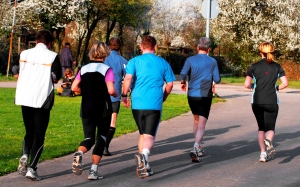 People who meet me and hear that my husband is a physio often say ‘Oh, you are so lucky’. I can only assume these people have not been to a physio and are confusing physiotherapy with massage.
People who meet me and hear that my husband is a physio often say ‘Oh, you are so lucky’. I can only assume these people have not been to a physio and are confusing physiotherapy with massage.
In my experience Physio is effective, sometimes pleasant, sometimes painful (in a way I know it’s working) and it often comes with ‘homework’. Until recently I have pretty much neglected the ‘homework’ bit, booked in for treatment as and when I needed it (I still book an appointment like everyone else) or sometimes I just chose to put up with discomfort or pain.
Twelve months ago I had (excuse the Oprah-ism) an ‘a-ha moment’. I don’t want to be the old stooped lady wishing that she’d worked harder at being fit and healthy when it counted. The very next day I booked in to see Emma and Urs and entirely committed to my ‘homework’ and it has had a much greater impact than simply improving my pain.
This is what I found out in the first three months:
- Doing my homework (which for me is a few weights sessions a week and posture correction several times a day) has essentially eliminated my pain.
- When I stop doing my homework for a week or so my pain rears its ugly head.
- Making a few posture-corrections and completing my weights training first thing in the morning fills me with an energy and optimism that fills the rest of my day.
This is where I am after 12 months:
- I have lost weight, which feels good but more to the point it has eliminated stress on my joints and I can work harder for longer at my exercise sessions without the major effort it used to be.
- When I am exercising (or just chasing the offspring) I am very aware of my limitations and after working with Urs, Emma and Kieria (and David) I understand how to engage various muscles to ‘protect’ the parts of my body prone to injury – avoiding injury.
- I have gotten to a point where having a long lounge on the couch is still very enjoyable, but only really after a big day.
 In beginning a rehab journey that for me may very well last for years (and maybe forever) I have begun to feel empowered with a control over my own body. I am beginning to learn ways in which to treat myself and understand what triggers and what improves my pain. In other words I no longer feel passive about my pain, my pain doesn’t own me or control me anymore.
In beginning a rehab journey that for me may very well last for years (and maybe forever) I have begun to feel empowered with a control over my own body. I am beginning to learn ways in which to treat myself and understand what triggers and what improves my pain. In other words I no longer feel passive about my pain, my pain doesn’t own me or control me anymore.
Next time you’re with your Physio or our Exercise Physiologist I urge you to begin a communication about how to self manage in the long term. Discuss what you can do at home, what we can help you with and any other services you may need to add to you self management ‘toolkit’. Like me you might get a lot more out of your experience than being pain free.






